With the rapidly evolving technology, the enterprise requirements continue to increase. As such, there is increased adoption of PaaS, SaaS, and cloud applications. Today information is not stored centrally, it is scattered and distributed across various applications, data centers, and databases. The biggest challenge enterprises face these days is the integration of data, which is coming from various web-based and on-premise applications. This is where the iPaaS tools come in.
Why Do We Need iPaaS Tools?
iPaaS (Integration Platforms as a Service) offers a centralized support to govern, handle, and integrate on-premise and cloud-based applications. The iPaaS tools serve by connecting services and applications and controlling integration flows. These tools accelerate product development by integrating available tools and enhance data volume by employing external sources. The enterprises utilize these tools to increase performance requirements, accumulate product functionalities, and organize application integrations. They support to include or remove features and data quickly and reduce failover, development time and downtime. Of course, there is some connection between ESB software and iPaaS, but iPaaS tools are typically employed in customer-facing applications while ESB tools work in internal data updates and transfers.
In order to succeed in adopting the iPaaS category, a tool must include the following characteristics:
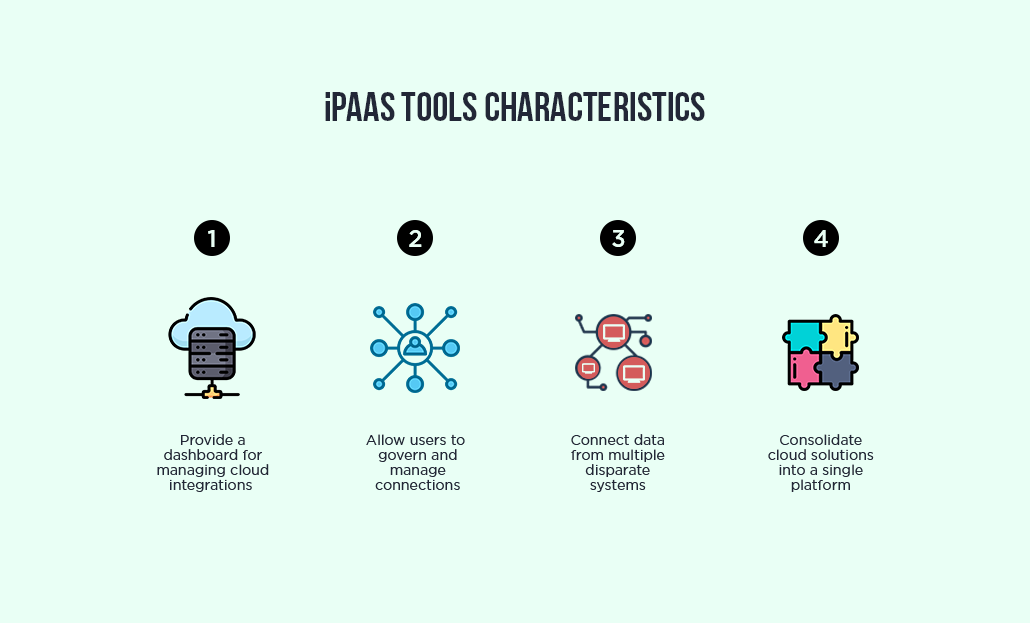
Features of iPaaS Software
The enterprises are purchasing integration solutions to integrate their existing and new systems and simplify their information technology environments. Most of them are recklessly embracing the platform without analyzing the integration functionalities. Integration in an extremely complex legacy business environment where a combination of on-premise and cloud applications is running simultaneously isn’t possible without an effective iPaaS solution. The following chart shows the most popular feature comparisons of various iPaaS software:
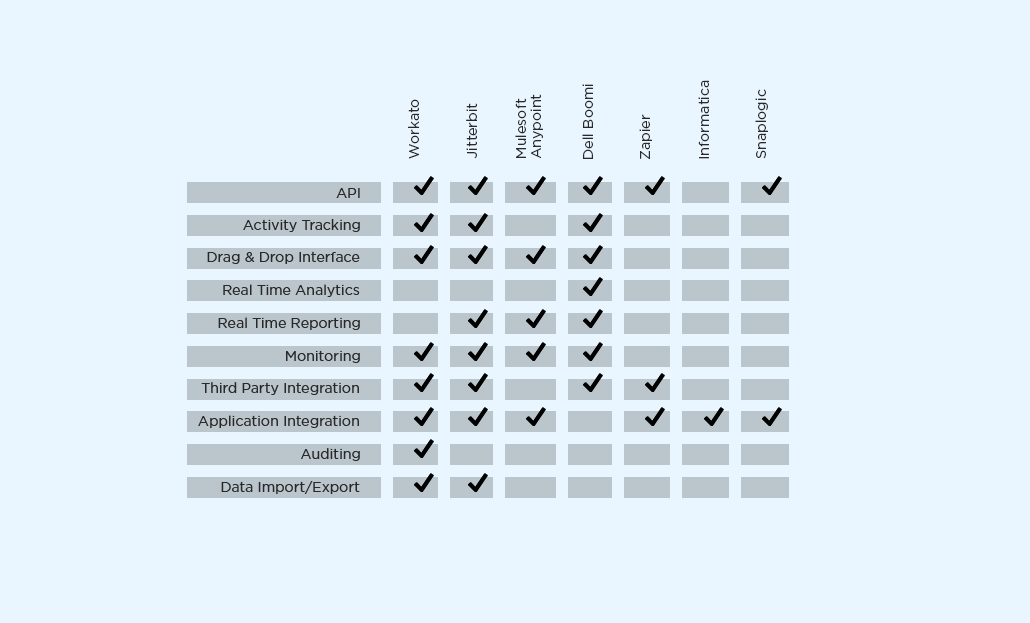
As per the report of Gartner, iPaaS solutions should come with capabilities listed below:
- Communication protocol connectors like FTP, HTTP, and others
- Application connectors for SaaS & on-premises packaged applications
- Data formats such as XML, JSON, Abstract Syntax Notation One and others
- Data standards such as Electronic Data Interchange for Administration, Health Level Seven (HL7) and others
- Data transformation
- Routing & orchestration
- Integration flow operational monitoring
- Integration lifecycle management tool
Let us dig deep into the common features that business can get with iPaaS tools:
1. Accelerate Data Transformation
When working with multiple systems and applications, the enterprise needs to execute into an incompatibility between inputs and outputs. To ensure data integrity in all integrated applications, iPaaS handle the entire needs of data transformation. It allows the user to make the bound to API-first connectivity. Whether there is a need to simplify existing APIs or rapidly produce new ones, the API platform of iPaaS allows to create, secure, run, handle, and evaluate all the APIs as well as microservices. Since the integration product and API functions on a single platform, the API can access any data source or applications either behind the firewall or on the cloud at any time. Business can even impart APIs with AI to transform the business processes. Some key features to innovate data transformation are as follows:
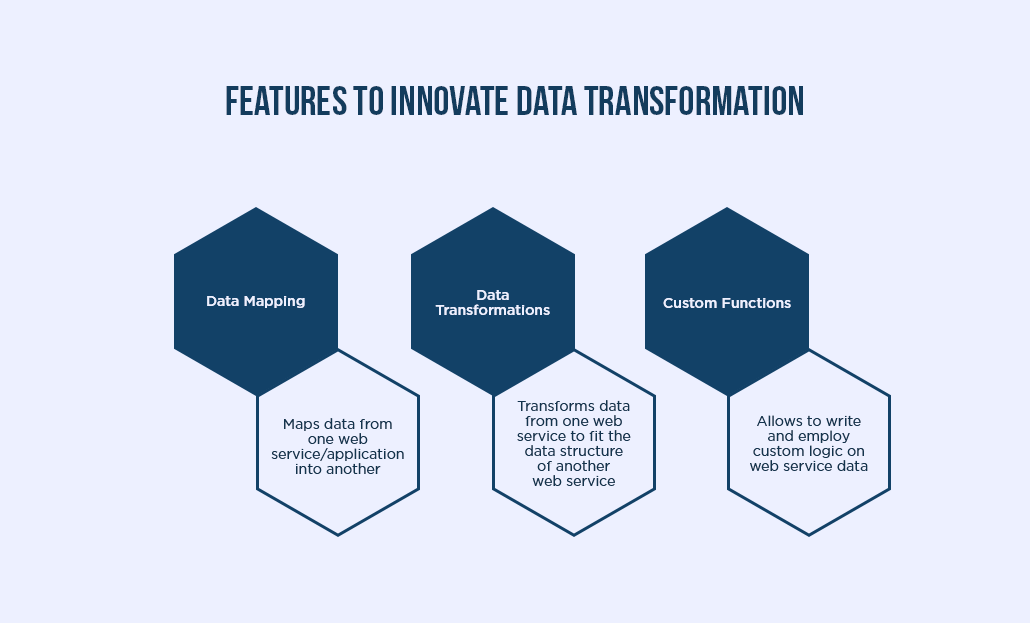
2. Smart API Versioning
The most pivotal portion in iPaaS integration is API versioning. Once a web app upgrades its API version, the iPaaS tools automatically made the relevant and vital changes to incorporate in the integration architecture. Most of the iPaaS tools handle the API changes and versioning by themselves while a very few expect from users to handle these changes and upgrades. While building integration iteratively using automatic version control, the enterprise can rollback to an older version and upgrade to a newer version. It ensures that users never lose any work.
3. Security
Most of the iPaaS software can be trusted with any sensitive data. Because of evolving cyber exploits, security has become the most critical factor of any business today. Especially, the process of integrating organizational data like personal information, customer records and passwords is more susceptible to misuse and data breach. To avoid this, the iPaaS software comes with robust security mechanisms like password protection, data encryption security certification, access control, session management, information security standards, and much more. The following chart depicts the security features available in various iPaaS tools:
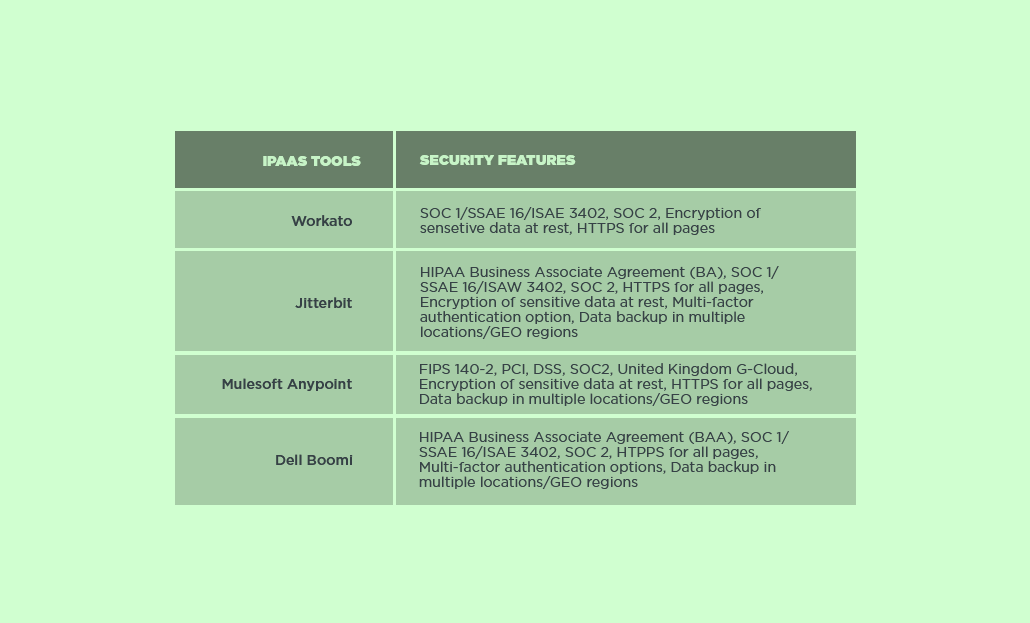
4. Connectivity and Integration
The ever-enhancing list of the connector is one of the boundless features of the iPaaS platform. Connectors allow triggering integration workflows and receiving data from & pushing data to several diverse applications on-premise or cloud through various protocols. With this software, users can easily integrate disparate systems, regardless of where they are. For example, a user who works in excel can continue working on Excel, without changing their tool. Since the apps interact behind the systems seamlessly. It allows cloning and sharing integration for improved collaboration and faster deployment. The iPaaS solution connects and integrates to a larger number of the system as depicted below:
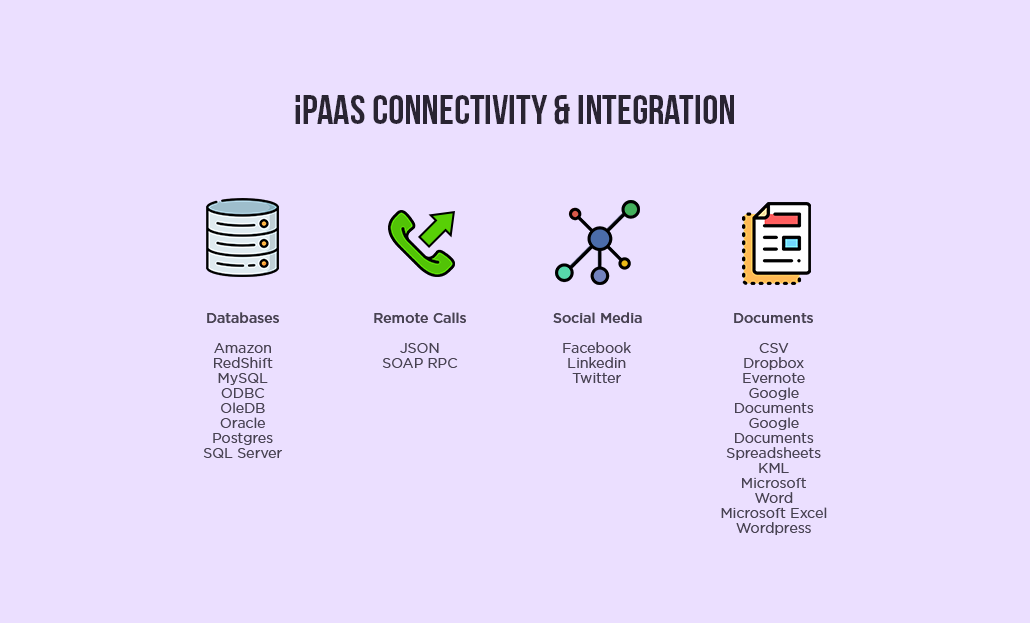
5. Monitoring & Notification
The iPaaS system offers an in-built monitoring feature that enables to check trigger history, run history, status, performance, etc. In addition to managing IoT endpoints, the software also monitors the data to ensure that it is analyzed, accumulated, consumed and distributed in a proper way. Furthermore, each time when a user executes an integration process, the software reports the result back. The notification comprises how long the process ran, how many records were executed, and how many failed. In addition, the users can observe the execution history associated with a solution in the user interface. The tools can also be configurable to send notifications through email when particular events happen. Notifications exist for record and solution failures, connector installations, system updates, and absence of agent communication.
6. Routing & Orchestration
Routing feature routes data from one app to another in accordance with the configuration. Additionally, the iPaaS software includes a robust orchestration engine, which is capable to handle complex workflows. It orchestrates integration solutions and defines how & what data can go through configuration. They offer the workflow visual designers to create, build, and handle the integration workflows. Generally, their workflows are serverless, therefore, it is enough to concentrate on the business value and functionality as the other scaling and infrastructure are fully abstracted. Some iPaaS solutions include low-code orchestration that enhances the speed and comfort of designing business logic. Application orchestration offers:
- A method to integrate, which decouples apps from each other
- A way to handle and monitor integration centrally
- Abilities for security, message routing, reliability and transformation
7. Integration Adapter Templates
Some iPaaS vendors begin to offer integration connectors as the templates, for subsequent adjustments and configurations. As such, the integration developers can directly access the source code of connectors. They can also receive the necessary workflows and tools to develop, test, and place modified connectors on production with less manual work. As the massive variety of apps lead to an enhanced demand for self-service tools for integration, the iPaaS platform comes with its own integration connectors. It supports multiple programming languages including Node.js.
8. Cloning and Customization
Taking a step further from offering templates, some iPaaS tools allow integration by cloning and customizing the available applications. Here, the automated workflows, which connect applications complete the task based on the combination of applications, triggers, and actions. Users have to choose the application they want to clone, set the trigger, and customize it with actions they want to automate.
9. Full Life Cycle API Management
Several comprehensive iPaaS platforms come with API management capabilities that enable to access and share real-time data in a rapid manner. With this feature, enterprises can manage all the APIs in a single platform with convenient scaling options. Furthermore, it offers absolute control over entire lifecycles from design to deployment and testing of APIs, which aids a more active way to append new functions when they become significant.
10. Visualize integratedData and Make Better Decisions
The iPaaS solution includes an option to increase visibility that allows access to real-time data exchanges, which enables to stay ahead of data integration ecosystem. Similarly, it allows creating custom reports effortlessly. Therefore, a business can generate operational dashboards with role-based prospects for the business, technical, and executive users. This visibility provides users with the ability to make better decisions and to detect & remove the information obstacle that obstructs integration.
11. Drag & Drop Interface
With the intuitive graphical user interface, a business can design, organize, and deploy integration workflows for on-premise and cloud applications. The graphical interface also allows creating and handling APIs through clicks. It enables visual API-based business processes and connects APIs in a few seconds. This capability empowers both technical and non-technical users to create integrations to streamline business processes. This easy-to-use interface facilitates everyone to generate workflows with no codes. In addition, users can build integration and automate business processes in a few clicks without code.
12. Data Formats and Standards
The iPaaS offers universal translation competencies for non-standard data formats. Furthermore, it supports a broad range of enterprise integration standards, including EDI, B2B, industry-specific standards like HL7, and standards-based web services. Similarly, with the modern data integration platform, the iPaaS software enables businesses to support their customers with all the data formats that they use in their ecosystem. This includes EDIFACTS, XML, JSON, and more.
Conclusion
Since iPaaS is rapidly gaining attraction, new software solutions are emerging every day. However, before investing in the software, enterprises should carefully evaluate the potential capabilities and benefits that come with iPaaS software and understand the recent vendor landscape.






